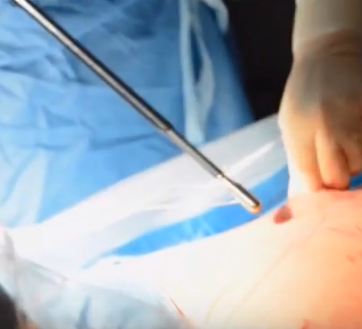Step-By-Step: RAPN with intracorporeal renal hypothermia using ice slush
Robot-assisted partial nephrectomy with intracorporeal renal hypothermia using ice slush: step-by-step technique and matched comparison with warm ischaemia
Objectives
To outline our step-by-step technique for intracorporeal renal cooling during robot-assisted partial nephrectomy (RAPN).
Patients and Methods
Patient selection was performed during a preoperative clinic visit. Cases where we estimated during preoperative assessment that warm ischaemia time would be >30 min, as determined by whether the patient had a complex renal mass, were selected. The special equipment required for this procedure includes an Ecolab Hush Slush machine (Microtek Medical Inc., Columbus, MS, USA) a Mon-a-therm needle thermocouple device (Covidien, Mansfield, MA, USA) and six modified 20-mL syringes. Patients are arranged in a 60° modified flank position with the operating table flexed slightly at the level of the anterior superior iliac spine. For the introduction of a temperature probe and ice slush, an additional 12-mm trocar is placed along the mid-axillary line beneath the costal margin. Modified 10/20 mL syringes are prefilled with ice slush for instillation via an accessory trocar. Peri-operative and 6-month functional outcomes in the cold ischaemia group were compared with those of a cohort of patients who underwent RAPN with warm ischaemia in a 2:1 matched fashion. Matching was performed based on preoperative estimated glomerular filtration rate (GFR), ischaemia time and RENAL nephrometry score.
Results
Strategies for successful intracorporeal renal cooling include: (i) placement of accessory port directly over the kidney; (ii) uniform ice consistency and modified syringes; (iii) sequential clamping of renal artery and vein; (iv) protection of the neighbouring intestine with a laparoscopic sponge; and (v) complete mobilization of the kidney. Kidney temperature is monitored via a needle thermocoupler device, while core body temperature is concurrently monitored via an oesophageal probe in real time. Renal function was assessed by serum creatinine level, estimated GFR (eGFR) and mercaptoacetyltriglycine (MAG-3) renal scan, peri-operatively and at 6-month follow-up. In the separate matched analysis, cold ischaemia during RAPN was found to be associated with a 12.9% improvement in preservation of postoperative eGFR. No difference was seen in either group at 6-month follow-up.
Conclusions
We conclude that RAPN with intracorporeal renal hypothermia using ice slush is technically feasible and may improve postoperative renal function in the short term. Our technique for intracorporeal hypotheramia is cost-effective, simple and highly reproducible.

